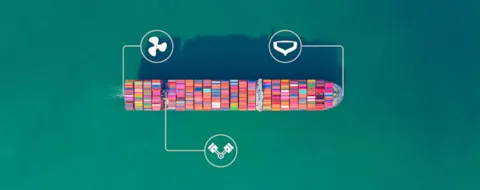EEXI overview and implementation
The Energy Efficiency eXisting ship Index (EEXI) is a measure which was introduced by the IMO to reduce the greenhouse gas emissions of ships. The EEXI is a measure related to the technical design of a ship. In case no changes to the energy efficiency are applied, ships have to attain EEXI approval only once in a lifetime. The initial certification was surveyed during the first periodical survey in 2023.
In certain scenarios, where the energy efficiency is affected, there is a need to re-certify the attained EEXI. In any case a company may, at any time, voluntarily request re-certification of the EEXI, with IEE Certificate reissuance, on the basis of any new improvements to the ships' efficiency. For possible scenarios and its effects, please visit Re-certification.
EEXI process for the fleet in service
Click here to open the graphic in higher resolution
Statutory compliance
With DNV’s digital self-service tool on the Veracity platform, which can be accessed via the “Vessel Services” tab in “Fleet Status”, you will be able to:
- calculate the EEXI value,
- compare the required and attained EEXI values,
- iterate the impact of engine power limitation
- generate the EEXI technical file and
- submit the technical file and OMM for approval.
After approval of the documentation and installation on board, a survey to be ordered for verification and issuance of new IEEC.
In case the modification is considered as so-called major conversion, not only the EEXI technical file but also the EEDI technical file to be updated. This is only valid for ships which were already built under the EEDI regime.
The main difference between the EEDI and the EEXI technical file is that for the newbuilding related index an overridable power limitation cannot be considered but only for the fleet in service index the overridable power limitation gives an improvement to the energy efficiency index. At the same time, EEDI required values are often less strict than required EEXI values, depending on the date of construction and the corresponding EEDI phase. From the table above, only the ship type change to be considered as major conversion.
The EEDI technical file can be handled in the same way as the EEXI technical file, meaning a new order to be placed in the digital self-service tool. The EEDI technical file to be manually uploaded as the EEXI template is not suitable for the EEDI technical file but the original EEDI technical file to be applied as template.
Class compliance of the alteration/conversion
Depending on the extend of the alteration documentation shall be submitted for approval. This can be done through the alteration portal.
After approval of the documentation and installation/changes on board, a survey can be booked, and the changes will be verified by a surveyor.
EEXI Digital Self-Service
Learn more about our EEXI calculator
Related links
EEXI and CII requirements taking effect from 1 January 2023
New statutory requirements entered into force on 1 January 2023. Key advice to consider.
IMO update: Marine Environment Protection Committee (MEPC 78)
Read our Technical and Regulatory News about the highlights from the MEPC 78
EU ETS - Emissions Trading System
Learn more about EU ETS and the requirements for complying with EU ETS
MRV – Monitoring, Reporting and Verification (EU and UK)
Visit our topic page
IMO DCS – Data Collection System
Discover more about IMO DCS
CII – Carbon Intensity Indicator
The CII measures how efficiently a ship transports goods or passengers. The ship is given an annual rating ranging from A to E.
Decarbonization Plan
A long-term decarbonization strategy to ensure cost-effective fleet compliance.

